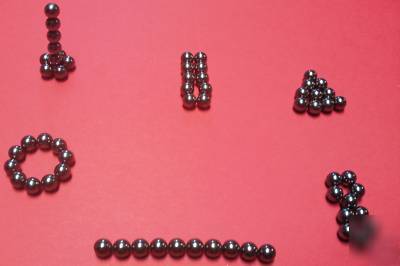Machine Recycling Discussion and Moderated Newsgroup > Full Machines
> Complete Machines
> CNC
> 10 neodymium magnets - hours of fun - most powerful
10 neodymium magnets - hours of fun - most powerful
From Wikipedia, the free encyclopedia
Rare-earth magnets are strong permanent magnets made from alloys of rare earth elements. Developed in the 1970s and 80s, rare-earth magnets are the strongest type of permanent magnets made, substantially stronger than ferrite or alnico magnets. The magnetic field typically produced by rare-earth magnets can be in excess of 1.4 teslas, whereas ferrite or ceramic magnets typically exhibit fields of 0.5 to 1 tesla. There are two types: neodymium magnets and samarium-cobalt magnets. Rare earth magnets are extremely brittle and also vulnerable to corrosion, so they are usually plated or coated to protect them from breaking and chipping.
The term "rare earth" can be misleading; these metals are not particularly rare or precious[citation needed], and as of 2007 rare earth magnets give the best cost/field ratios of any permanent magnet.[citation needed] Interest in rare earth compounds as permanent magnets began in 1966, when K. J. Strnat and G. Hoffer of the US Air Force Materials Laboratory discovered that YCo5 had by far the largest magnetic anisotropy constant of any material then known.[1]
The rare earth (lanthanide) elements are metals that are ferromagnetic, meaning that like iron they can be magnetized, but their Curie temperatures are below room temperature, so in pure form their magnetism only appears at low temperatures. However, they form compounds with the transition metals such as iron, nickel, and cobalt, and some of these have Curie temperatures well above room temperature. Rare earth magnets are made from these compounds.
The advantage of the rare earths and their compounds over other magnets is that their crystalline structures have very high magnetic anisotropy. This means that a crystal of the material is easy to magnetize in one particular direction, but resists being magnetized in any other direction.
The high anisotropy of a rare earth element, as well as its other magnetic properties, is related to its incompletely filled f-shell. Electrons in such orbitals are strongly localized and therefore easily retain their magnetic moments and function as paramagnetic centers. Magnetic moments in other orbitals are often lost due to strong overlap with the neighbors. In addition, the f-shell can contain up to 7 unpaired electrons, enhancing the size of the magnetic moment.
Main article: Neodymium magnet
Neodymium magnets, invented in the 1980s, are the strongest and most affordable type of rare-earth magnet. Neodymium alloy (Nd2Fe14B) is made of neodymium, iron and boron. Neodymium magnets are typically used in most computer hard drives and a variety of audio speakers. They have the highest magnetic field strength, but are inferior to samarium-cobalt in resistance to oxidation and Curie temperature. Use of protective surface treatments such as gold, nickel, zinc and tin plating and epoxy resin coating can provide corrosion protection where required.
Originally, the high cost of these magnets limited their use to applications requiring compactness together with high field strength. Both raw materials and patent licenses were expensive. Beginning in the 1990s, NIB magnets have become steadily less expensive, and the low cost has inspired new uses such as children's magnetic building toys.
Some important properties used to compare permanent magnets are: remanence (Br), which measures the strength of the magnetic field; coercivity (Hci), the material's resistance to becoming demagnetized; energy product (BHmax), the density of magnetic energy; and Curie temperature (Tc), the temperature at which the material loses its magnetism. Rare earth magnets have higher remanence, much higher coercivity and energy product, but (for neodymium) lower Curie temperature than other types. The table below compares the magnetic performance of the two types of rare earth magnet, neodymium (Nd2Fe14B) and samarium-cobalt (SmCo5), with other types of permanent magnets.
My 4yr. old Grand Daughter loves to play with these. She has a Ball! However, I am ALWAYS with her when she has them.

